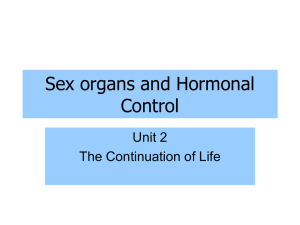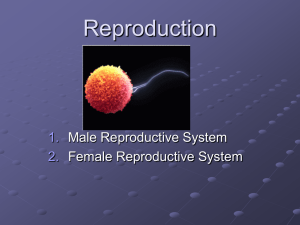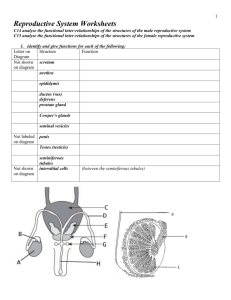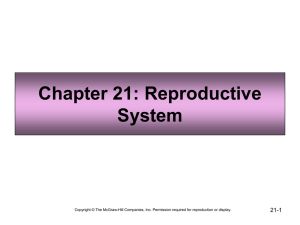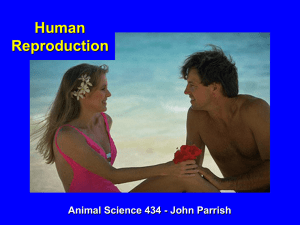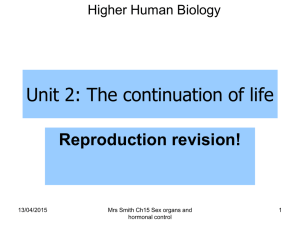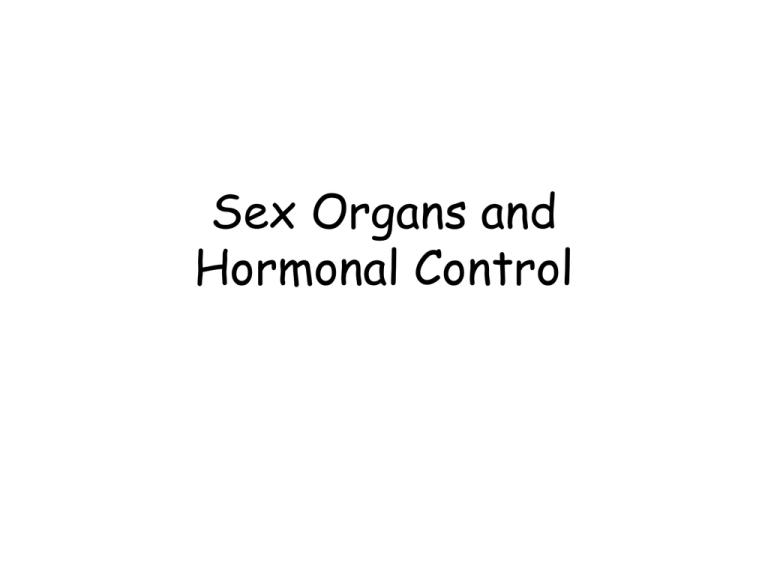
Sex Organs and
Hormonal Control
Male Reproductive System
Testis
Testis
Sperm
tail
head
nucleus
Male Structure and Function 1
Structure
TESTIS
Function
Site of sperm and testosterone
production
EPIDIDYMIS
Outer area of the testis
SEMINIFEROUS
TUBULES
Tubes in the testis where sperm are
produced from sperm mother cells during
meiosis.
Located between the seminiferous tubules
in the testis. Produce testosterone,
which passes directly in to the blood.
Tube through which spermatozoa is
ejaculated and urine is excreted.
INTERSTITIAL
CELLS
URETHRA
PENIS
Consists of erectile tissue and blood
vessels. The urethra is extended into
the penis.
Male Structure and Function 2
SEMINAL
VESICLE
PROSTATE
GLAND
SPERM DUCT
Secretes a viscous liquid rich in fructose
and prostagladins. Fructose provides sperm
with the energy required to swim.
Prostagladins are hormone-like compounds,
which stimulate contractions of the female’s
reproductive tract.
Secretes a thin lubricating liquid containing
enzymes whose actions maintain the fluid
medium at the optimum viscosity for sperm
mobility.
Tube through which spermatozoa leave the
testis and enter the urethra.
Female Reproductive System
Female Reproductive System
Ovary
Female Structure and Function 1
Structure
OVARY
UTERUS
CERVIX
OVIDUCT
ENDOMETRIUM
VAGINA
Function
Site of ovum/egg production through
meiotic division.
Embryo develops here
Neck of the uterus
Site of fertilisation. Tube through
which sperm swim to the egg and
through which the egg is propelled
down towards the uterus.
Lining of the uterus
Birth canal. Area of the female’s
body where the male’s penis enters
Female Structure and Function 2
Structure
Function
Graafian follicle
Encloses the developing ovum
and secretes
oestrogen
______________________
Corpus luteum
Develops after ovulation and
secretes
progesterone
______________________
Notes
• The male sex cells are ……………. They are produced in the
………… This is also where the male sex hormone ………………
is produced. Sperm are formed by ……………… in the
seminiferous tubules which join together and connect to
the …………………… Testosterone is produced by …………………
……………… between the seminiferous tubules and passes
directly into the blood stream. Sperm are motile. This
requires a …………… medium and a source of …………………
Fertilisation takes place in the …………………… Semen is a
fluid produced by the seminal vesicles that contains
………………… and ………………… It also contains …………………
secreted from the prostate gland. Fructose provides
energy, prostaglandins stimulate contraction of the
female reproductive tract helping sperm to reach the
oviduct faster. Enzymes maintain ……………… of the fluid
medium.
Notes
• The female sex cell is the …………
(ovum). They are formed by ……………
in the ……………… The egg is contained
in a ……………… ……………… This secretes
the female sex hormone ……………………
After the egg has been released
(…………………..), the follicle develops
into a corpus luteum which secretes
the sex hormone …………………………
Notes (answers)
• The male sex cells are sperm. They are produced in the
testes. This is also where the male sex hormone
testosterone is produced. Sperm are formed by
meiosis in the seminiferous tubules which join together
and connect to the sperm duct Testosterone is
produced by interstitial cells between the
seminiferous tubules and passes directly into the blood
stream. Sperm are motile. This requires a fluid
medium and a source of energy. Fertilisation takes place
in the oviduct. Semen is a fluid produced by the
seminal vesicles that contains fructoseandprostaglandins
It also contains enzymes secreted from the prostate
gland. Fructose provides energy, prostaglandins
stimulate contraction of the female reproductive tract
helping sperm to reach the oviduct faster. Enzymes
maintain viscosity of the fluid medium.
Notes (answers)
• The female sex cell is the egg
(ovum). They are formed by meiosis
in the ovaries. The egg is contained
in a graafian follicle. This secretes
the female sex hormone oestrogen.
After the egg has been released
(ovulation), the follicle develops into a
corpus luteum which secretes the sex
hormone progesterone.
Gonadotrophic Hormones
• These are secreted by the pituitary
gland in the brain.
• They target the reproductive organs
and are carried by the blood.
• Female gonadotrophic hormones are
FSH (follicle stimulating hormone)
and LH (luteinising hormone).
• Male gonadotrophic hormones are
FSH and ICSH (interstitial cell
stimulating hormone)
Male Gonadotrophins
• FSH targets the testis and promotes
sperm production in the seminiferous
tubules.
• ICSH targets the testis and
stimulates the interstitial cells to
produce testosterone (which also
stimulates sperm production). It also
stimulates secretions by the prostate
gland and seminal vesicles.
Self Regulation of Testosterone
Female Gonadotrophins
• FSH targets the ovaries and
stimulates the development and
maturation of the Graafian follicle.
It also stimulates the secretion of
oestrogen by the ovary tissue.
• LH triggers ovulation. It also brings
about the development of the corpus
luteum and the secretion of
progesterone.
Influence of Pituitary Hormones
Influence of Ovarian Hormones
• Oestrogen stimulates proliferation of
the endometrium. It also stimulates
the secretion of LH by the pituitary.
• Progesterone promotes thickening of
the endometrium. It also inhibits the
secretion of FSH and LH by the
pituitary
Effect of Progesterone
Male Hormones Summary
Hormone
FSH
ICSH
Secreted from
Target area
Effect
ANTERIOR
PITUITARY
SEMINIFEROUS
TUBULES
(TESTES)
SPERM
PRODUCTION
ANTERIOR
PITUITARY
INTERSTITIAL TESTOSTERONE
CELLS
PRODUCTION
(TESTES)
Testoster
one
INTERSTITIAL
CELLS
(TESTES)
SEMINIFEROUS
TUBULES
(TESTES)
SPERM
PRODUCTION
Female Hormone Summary
Hormone
FSH
LH
Oestrogen
Secreted from
Target area
ANTERIOR
PITUITARY
OVARY
ANTERIOR
PITUITARY
OVARIAN
TISSUE
(GRAAFIAN
FOLLICLE)
Progesterone
CORPUS LUTEUM
OVARY
UTERUS AND
ANTERIOR
PITUITARY
UTERUS AND
ANTERIOR
PITUITARY
Effect
MATURATION
OF FOLLICLE
TRIGGERS
OVULATION AND
DEVELOPMENT OF
CORPUS LUTEUM
PROLIFERATION
OF ENDOMETRIUM
AND SECRETION
OF LH
THICKENING OF
ENDOMETRIUM AND
INHIBITS
SECRETION OF FSH
AND LH
m e n s tru a tio n
n e w c y c le
LH
C o n c e n tra tio n o f
FSH and LH
in b lo o d
FSH
progesterone
oestrogens
C o n c e n tra tio n o f
o e s tro g e n s a n d
p ro g e s te ro n e
in b lo o d
1 2 3 4 5 6 7 8 9 1 0 11 1 2 1 3 1 4 1 5 1 6 1 7 1 8 1 9 2 0 2 1 2 2 2 3
25 26 27 28
T im e (d a y s )
o o c y te
O VA RY
p rim a ry
fo llic le
d e v e lo p in g
fo llic le s
o v u la tio n
P
R
O
G
E
S
T
E
R
O
N
E
&
S
O
M
E
O
E
S
T
R
O
G
E
N
S
OESTROGENS
UTERUS
(th ic k n e s s o f
e n d o m e triu m )
1
m enses
5
c o rp u s
lu te u m
14
fo llic u la r p h a s e
28
lu te a l o r s e c re to ry p h a s e
Fertilisation
• Nuclei of male and female gamete
fuse together to form a zygote.
Fertilisation
After fertilisation the egg secretes HCG (human chorionic
gonadotrophin) which maintains the corpus luteum which
secretes progesterone and prevents menstruation. After 6 weeks
the placenta secretes progestrone
Cervix
• Cells which line the cervix secrete
mucus which lubricates the vagina.
• Mucus secretion is stimulated by
oestrogen.
• High levels of progesterone in the
luteal phase causing the mucus to
become more viscous and during
pregnancy it forms a ‘plug’ to protect
the fertilised egg from infection.
Body Temp Changes
• At ovulation, the body temp rises by
about 0.5oC.
• It remains at this high level during
the luteal phase.
Fertility
• Men are continuously fertile due to a
steady quantity of testosterone
production.
• Women have cyclical fertility and are
only fertile 3/4days following
ovulation.

